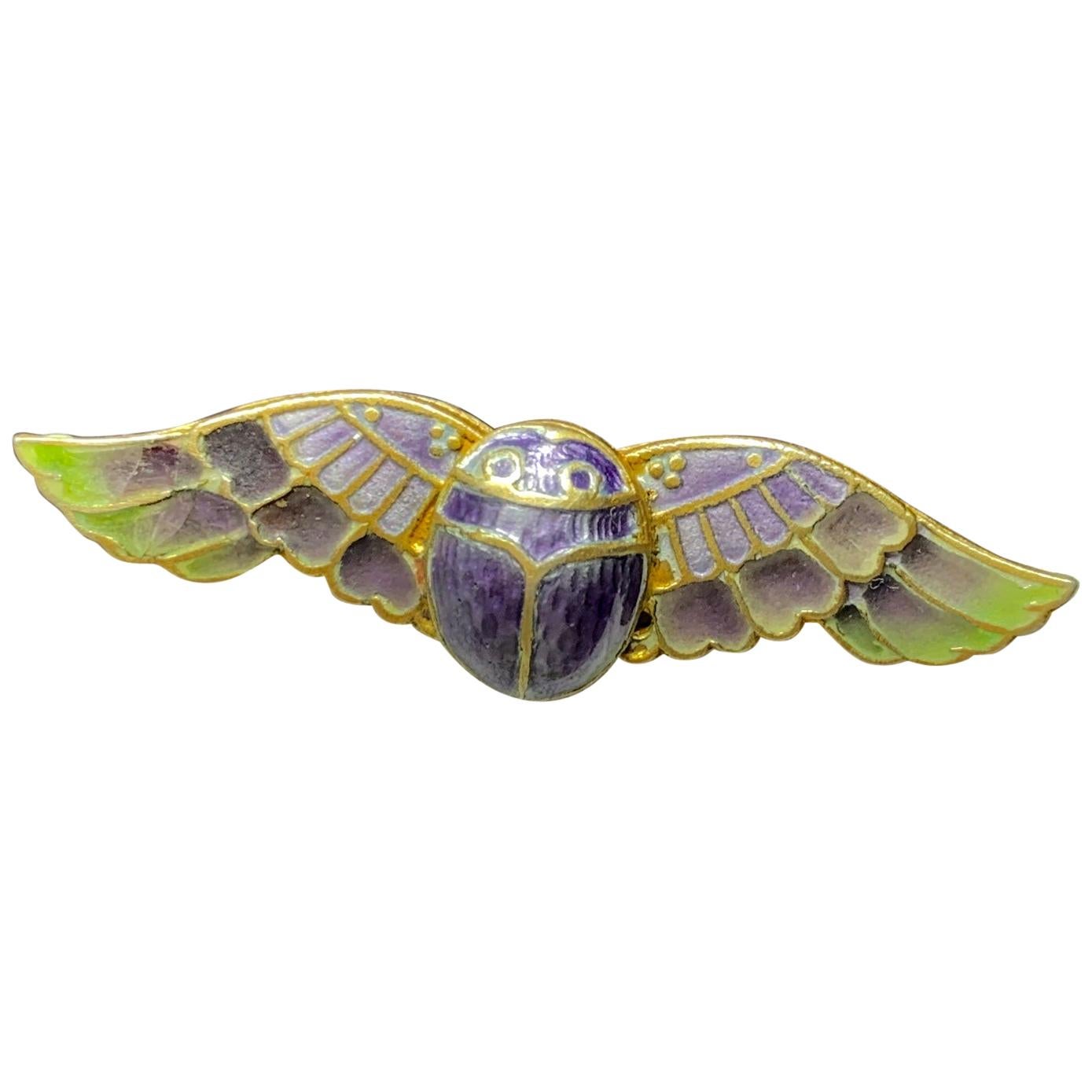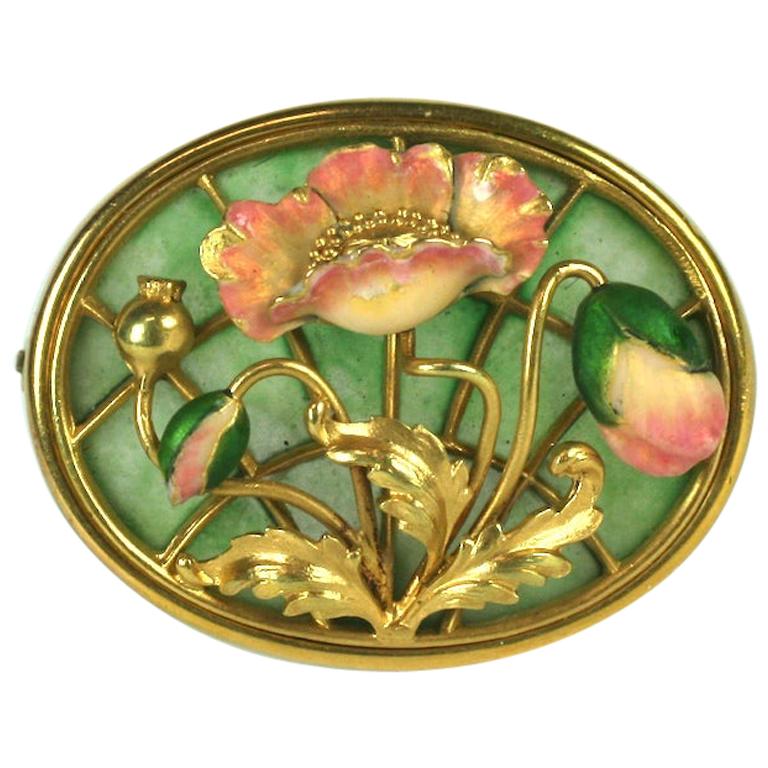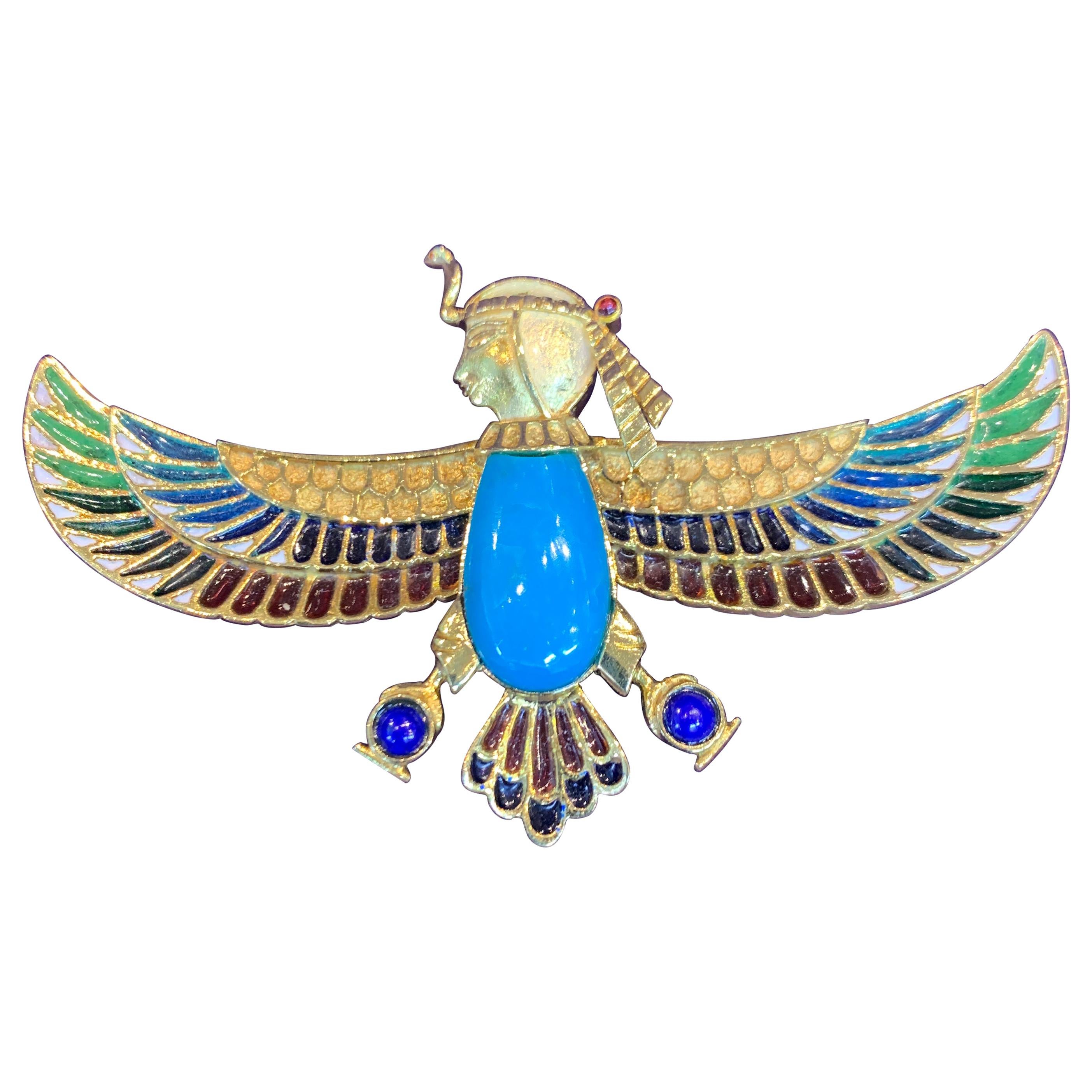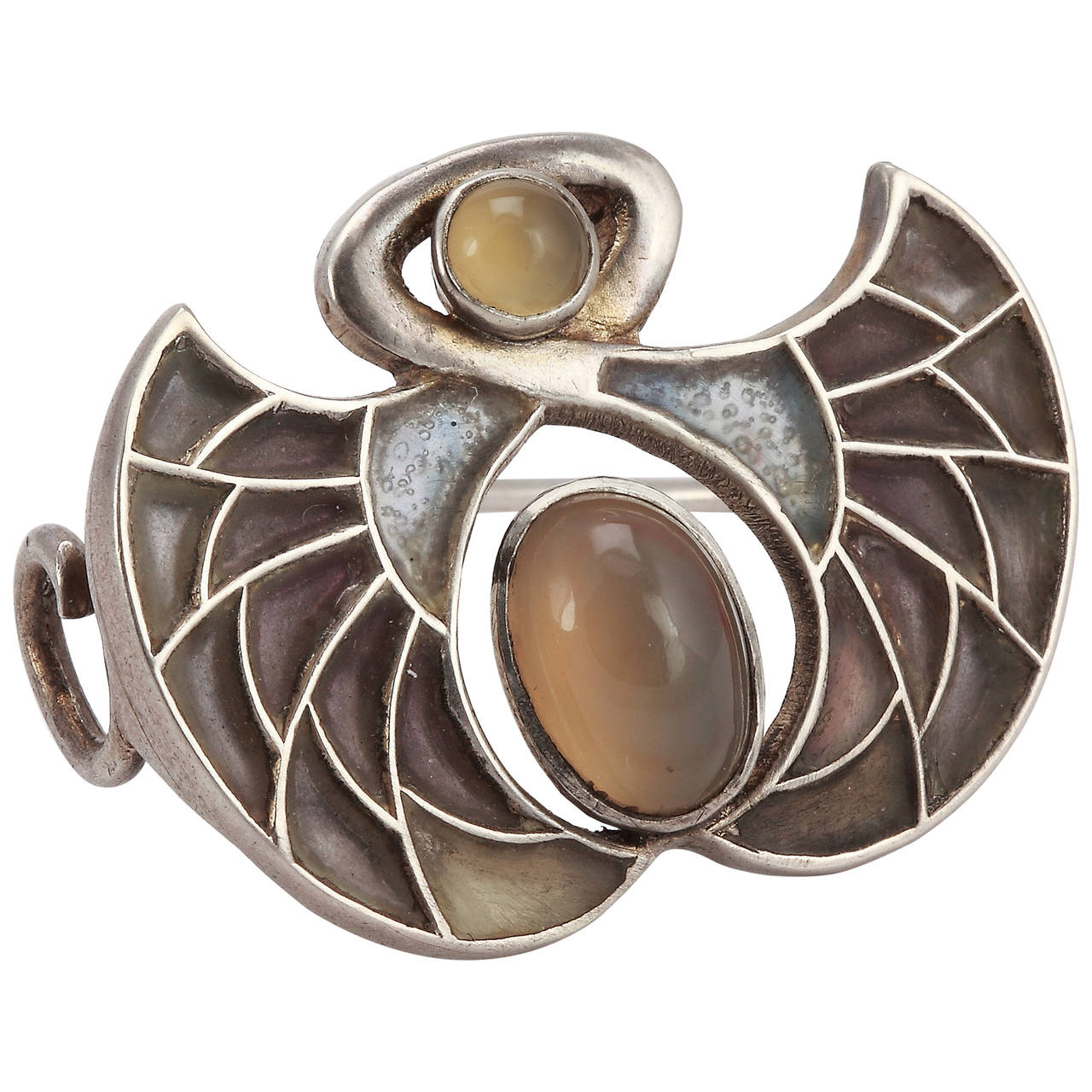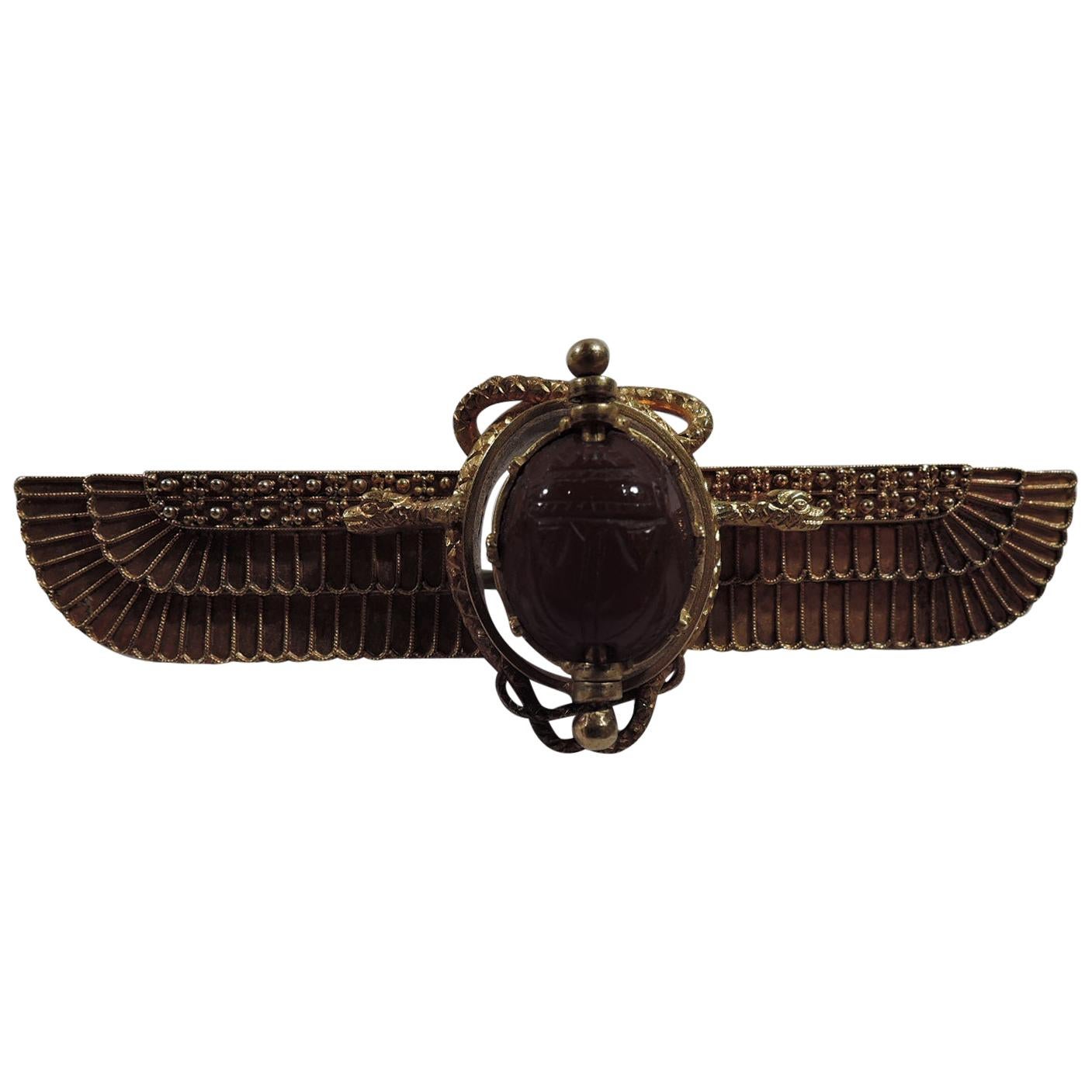Items Similar to Austrian 1915 Art Nouveau Egyptian Revival Plique à Jour Winged Scarab Brooch
Want more images or videos?
Request additional images or videos from the seller
1 of 8
Austrian 1915 Art Nouveau Egyptian Revival Plique à Jour Winged Scarab Brooch
About the Item
Austrian Egyptian revival Plique à Jour winged Scarab brooch
An exceptional elongated brooch, created in Austria during the art nouveau period, back in the 1915. This magnifique piece has been carefully crafted with the egyptian revival style, in solid .900/.999 silver with brushed finish. The wings are accented with applications of the difficult technique of Plique à Jour in translucent yellow-green and bluish-gray enamels. Fitted at the reverse with a hinged horizontal bar with a security lock. The figure represent the Egyptian sacred scarab with open feathers wings, of the god Khepri.
Quartz Stones: Mount in bezel settings, with 2 round cut of blue quartz.
Opal: Mount in a bezel setting, with 1 oval cabochon cut of a natural opal of about 2.75 carats.
Weight: 17.95 Grams, (11.50 Dwt).
Measurements: 108 mm by 26 mm (4.25 x 1.02 Inches).
Hallmarks: Stamped with the maker's mark inside a circle, the mark for the assay of the silver and signed, "FL DEPOSE STERLING .900".
Egyptian Winged Scarab
This kind of beetle was highly symbolic to ancient Egyptians, it represented rebirth and renewal. They believed that the sun was pushed across the sky every day by a giant scarab, the god Khepri. In real life, the scarab beetle lays its eggs in a ball of dung and rolls the ball ahead of it wherever it goes. Originated in Ancient Egypt. A scarab is shaped like a dung beetle. There is a head, wing case, and legs. It is sometimes rounded and sometimes flat. The scarab was associated with the god Khepri who was the god or rebirth, creation, and the sun. Dung beetles were the earthly personification of Khepri as they would lay their eggs in balls of dung and then roll the dung balls all around until the eggs hatched. Early hieroglyphics depict Khepri as a scarab holding up the sun. There were hundreds of memorial scarabs created to memorialize Amenhotep III’s deeds. These included the bull hunt scarab which symbolizes strength and victory over chaos. Later, around 2000 BCE the scarab was used in jewelry and as seals. The amulets were worn as protection against the dangers of this world and the afterlife. The scarab represented the sun god Ra that rolled across the sky each day. Between the 16th and 11th- century heart scarabs were created to be placed on a mummy’s heart. When a person reached the afterlife their heart was weighed by the goddess of truth. If the heart was heavy with sin they could not move forward to the afterlife. The heart scarab would convince the gods that the person was trustworthy and should move into the afterlife without having their heart weighed. Other heart scarabs were used as general protection to the afterlife.
Egyptian Revival Jewelry
For centuries, Ancient Egypt has held the fascination of the public and continues to inspire artists and designers alike. Between the 1860 and 1890, ancient cities were discovered, such as Troy, Pompeii and Alexandria. Archaeological excavations in Egypt, Greece and Rome, discovered artistic pieces of these ancient cultures. These fabulous discoveries, stimulated cultural trips to these countries, popularly called "grand tour". Being the case that the enthusiast visitors bring back small objects, like souvenirs to be assembled into jewelry. The starting point of these trips were in the cities of Rome and Venice.
Art Nouveau Jewelry
or new art jewelry was created in France between about 1895 and 1910, coming on the heels of the “overwrought” designs of the Victorian era (which ended with Queen Victoria's death in 1901) and creating a striking contrast to the mainstream Edwardian designs of that time. While jewelry with a similar aesthetic was being made in other countries during the same time period--for example, Jugendstil in Germany and Austria--true Art Nouveau jewelry is decidedly extended in France. It was a short-lived period in jewelry design, lasting only about 15 years, because of the onset of World War I and because the pieces were so over-the-top that people quickly lost interest in them. Characterised by lavish and organic ornamentation, the Art Nouveau movement blossomed in Vienna at the turn of the 20th Century, with influential Austrians architects Otto Wagner and Adolf Loos making significant architectural contributions that helped shape the city's skyline as we see it today. Rene Lalique, was the most celebrated art nouveau designer, championed jewelry designer.
Plique à jour
Derivate from the French is "letting in daylight". Is a very difficult vitreous enamelling technique where the enamel is applied in cells, similar to cloisonné, but with no backing in the final product, so light can shine through the transparent or translucent enamel. It is in effect a miniature version of stained-glass and is considered very challenging technically: high time consumption (up to 4 months per item), with a high failure rate. The technique is similar to that of cloisonné, but using a temporary backing that after firing is dissolved by acid or rubbed away. A different technique relies solely on surface tension, for smaller areas. In Japan the technique is known as shotai-jippo (shotai shippo), and is found from the 19th century on.
Collateral: This brooch is accompanied by a presentation jewelry box.
Condition: The overall condition of this brooch is excellent. Beside the little normal wear, there is no damage to the silver. The enamel and the gems are secured in the settings. This piece has been carefully inspected to guarantee the condition and authenticity.
INVENTORY REF: P021023MSNM/.5321
- Creator:Egyptian Revival
- Metal:Silver,Enamel
- Stone:Opal,Quartz
- Stone Cut:Cabochon
- Weight:2.75 ct
- Dimensions:Width: 1.02 in (25.91 mm)Depth: 0.28 in (7.12 mm)Length: 4.25 in (107.95 mm)
- Style:Art Nouveau
- Place of Origin:Austria
- Period:1910-1919
- Date of Manufacture:1915
- Condition:Wear consistent with age and use. The overall condition of this brooch is excellent. Beside the little normal wear, there is no damage to the silver. The enamel and the gems are secured in the settings. This piece has been carefully inspected to guarantee the condition and authentici.
- Seller Location:Miami, FL
- Reference Number:
About the Seller
4.9
Recognized Seller
These prestigious sellers are industry leaders and represent the highest echelon for item quality and design.
Platinum Seller
These expertly vetted sellers are 1stDibs' most experienced sellers and are rated highest by our customers.
Established in 1995
1stDibs seller since 2022
434 sales on 1stDibs
Typical response time: <1 hour
- ShippingRetrieving quote...Ships From: Miami, FL
- Return PolicyA return for this item may be initiated within 1 day of delivery.
More From This SellerView All
- Art Nouveau 1890 Plique a Jour Pendant Brooch in 18kt Gold Diamonds Pearls RubyLocated in Miami, FLArt Nouveau Plique à jour pendant brooch. A exceptional piece, created during the Art Nouveau period, back in the 1890. Surely It was crafted in Austria or Germany with the difficul...Category
Antique 1890s Austrian Art Nouveau Pendant Necklaces
MaterialsRuby, Natural Pearl, Pearl, White Diamond, Diamond, Enamel, Yellow Gold,...
- Meyle & Mayer 1910 Art Nouveau Gilt Silver Pendant With Enamel & Plique Au JourLocated in Miami, FLAn art nouveau slide mirror pendant designed by Meyle & Mayer. Fabulous piece, created in Pforzheim Germany by Meyle & Mayer during the art nouve...Category
Vintage 1910s German Art Nouveau Pendant Necklaces
MaterialsChrysophrase, Sapphire, Blue Sapphire, Silver, Enamel
- Austria 1905 Edwardian Art Nouveau Brooch Platinum with Rock Quartz and DiamondsLocated in Miami, FLEdwardian art nouveau brooch made in Austria by Franz Goldstein. Beautiful and rare piece, created in Vienna Austria by the jeweler Franz Gol...Category
Antique Early 1900s Austrian Edwardian Brooches
MaterialsQuartz, Natural Pearl, Pearl, White Diamond, Diamond, Platinum, White Go...
- Roman 1880 Etruscan Revival Mechanical Scarab Brooch In 18Kt Gold With OpalsLocated in Miami, FLEtruscan revival mechanical beetle brooch. Fabulous antique piece, created in Rome Italy in the 19th century, circa 1870-1880. This magnificent brooch has been made in the shape of a scarab, with patterns of Etruscan and renaissance revival. Carefully crafted with multiples parts, made-ups in solid rich yellow gold of 18 karats which are finished with textured and incised designs. The wings of the scarab can be opened and close by a mechanical push button in the shape of a pistil to discover an arrangement of gemstones. It is embellished with a great assortment of natural earth mined opals...Category
Antique 1880s Italian Etruscan Revival Brooches
MaterialsOpal, Ruby, Gold, 18k Gold, Yellow Gold
- Austrian 1900 Art Nouveau Jugendstil Brooch in 14 Karat with Coral and PearlLocated in Miami, FLJugendstil brooch made in Austria. An exceptional piece of Jugendstil art, created in Austria or Germany back in the 1900. Crafted during the...Category
Antique Early 1900s Austrian Art Nouveau Brooches
MaterialsCoral, Pearl, Gold, 14k Gold, Yellow Gold
- Masriera Art Nouveau Plique À Jour Enamel Ring in 18Kt Yellow Gold with DiamondsBy MasrieraLocated in Miami, FLAn art nouveau enameled ring designed by Masriera. Colorful piece, created in Barcelona Spain by the jewelry designer Gloria Masriera for Masriera. This beautiful ring has been crafted with art nouveau revival patterns in solid rich yellow gold of 18 karats with high polished finish. The ring has been created with organic flowers design and embellished with application of translucent multicolor enamels in the plique a jour technique. Diamonds: Mount in a millegrain setting, with 31 round brilliant cut diamonds, 0.62 carats, white colorless E color, VS-1 clarity. Weight: 9.35 Grams, (5.99 Dwt). Size: 6.75 sizeable. Measurements: 22 mm by 15 mm (0.87 x 0.59 Inches). Hallmarks: Stamped with the maker's mark, the gold assay mark, the serial numbers and signed in full, "MASRIERA Y CARRERA...Category
Late 20th Century Spanish Art Nouveau Band Rings
MaterialsDiamond, White Diamond, Gold, 18k Gold, Yellow Gold, Enamel
You May Also Like
- Egyptian Revival Plique A Jour Enamel Winged Scarab Insect Brooch Pin Art DecoLocated in New York, NYA rare Art Deco Egyptian Revival masterpiece of a Winged Scarab Insect Brooch done in Plique a Jour Enamel over Silver. The Museum Quality brooch depicts a winged Scarab beetle, one...Category
Early 20th Century Unknown Art Deco Brooches
MaterialsSilver, Enamel
- Egyptian Revival Plique-à-Jour Carved Carnelian Scarab Eagle Pin, 1923Located in Lexington, KYThis pin is quite the piece! This Egyptian Revival pin features a lovely scarab in the center made of carved carnelian! The wings on this eagle ar...Category
Vintage 1920s Unknown Egyptian Revival Brooches
MaterialsCarnelian, Gilt Metal
- American Art Nouveau Plique a Jour BroochLocated in Riverdale, NYWonderful American Art Nouveau 14k Plique a Jour Brooch of enameled poppies on a pale green plique a jour ground. Flowers modeled in high relief w...Category
Antique Early 1900s American Art Nouveau Brooches
Materials14k Gold
- Egyptian Revival Turquoise and Plique a Jour enamel Sphinx BroochLocated in New York, NYEgyptian Revival Turquoise sphinx Brooch with multi color plique a jour enamel Measurements: 3 inches long Unidentified marker mark "RB" 19 GramsCategory
Vintage 1980s Unknown Egyptian Revival Brooches
MaterialsTurquoise, Yellow Gold
- Heinrich Levinger Art Nouveau Plique-a-Jour Silver BroochLocated in Berlin, DEThe brooch was made by Heinrich Levinger in Pforzheim, Germany, around 1902. Stylized wings form with plique-a-jour enamel decoration and 2 cabochon ...Category
20th Century Art Nouveau Brooches
MaterialsSterling Silver
- Antique Egyptian-Revival 18 Karat Gold Winged Sun Brooch with ScarabLocated in New York, NYEnglish Egyptian-Revival 18K gold brooch with scarab, ca 1870. Winged sun with fluted and stepped form. Entwined and scaly serpent forms round and open center, which supports a rotat...Category
Antique Late 19th Century English Egyptian Revival Brooches
Materials18k Gold, Yellow Gold
Recently Viewed
View AllMore Ways To Browse
Antique Jewellery Other
Antique Jewelry Makers
Antique Jewelry New
Jewellery Discovery
Art Nouveau Jewellery Blue
Heavy Antique Jewellery
Art Nouveau Setting
New Antique Jewellery Designs
Egyptian Revival Jewelry
Egyptian Revival Jewellery
Egyptian Revival Jewlery
Ancient Egyptian Jewelry
Ancient Egyptian Jewlery
Art Nouveau Cabochon
Nouveau Cabochon
1915 Edwardian
Scarab Jewellery
Scarab Jewelry
